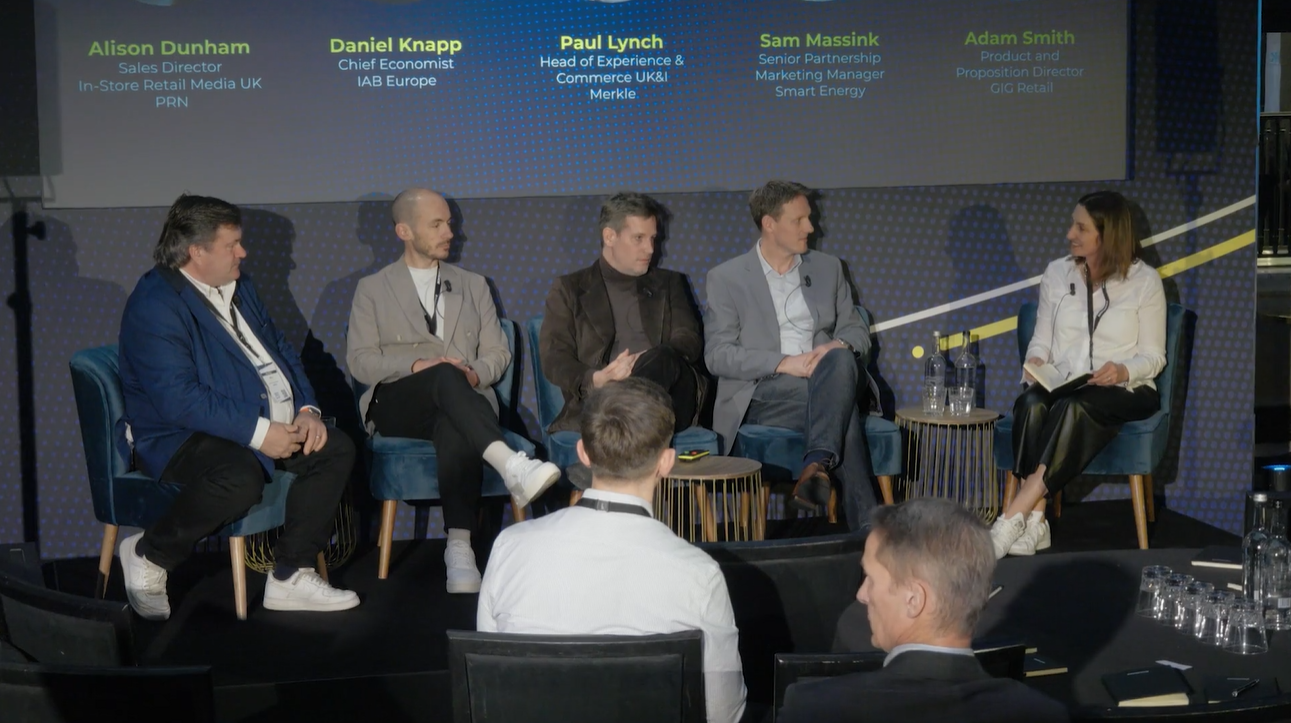




As in-store retail media continues to emerge as the next frontier in omnichannel advertising, measurement, standardization and actionable insights are rising to the top of the industry’s collective priority list. At the latest “What’s In-Store for Retail Media Networks” event in London, a panel of retail media experts explored one of the most pressing challenges in the space: How do we define, measure and scale in-store media impact with confidence and consistency?
Chaired by Alison Dunham of PRN and featuring leaders from GIG Retail, IAB Europe, Merkle, and Smart Energy GB, the discussion revolved around the IAB’s recently launched in-store media measurement standards — developed in collaboration with 14 European retailers and now available for industry-wide adoption.
Daniel Knapp, Chief Economist at IAB Europe, outlined the process of developing these standards, describing it as a balancing act between idealism and practical implementation. “It’s a foundation,” Knapp said, “imperfect, but designed to hit the road fast.” The new guidelines codify three key areas:
While full-scale adoption is still unfolding, Knapp expressed confidence in the industry’s direction. “Retailers see value in comparability and interoperability — if in-store is to be part of the omnichannel equation, it must align with digital expectations.”
For agencies like GIG Retail, supporting this transformation is both opportunity and obligation. Adam Smith, Product and Proposition Director, noted that agencies are playing a vital role in guiding retailers toward adopting the standards. “We’re seeing the shift from trade to brand,” he explained. “Suppliers are becoming clients, and that demands a change in approach.”
Smith believes that in-store measurement is uniquely positioned for success compared to online, citing the potential for seamless, invisible technologies, like radar or beacon-based sensors, to generate compliant, real-time insights without disrupting the shopper experience.
Paul Lynch, Head of Experience & Commerce UK&I at Merkle, highlighted how standards make collaboration easier across brands, retailers and media agencies. “Having a common framework helps us create joined-up campaigns,” he said. He referenced innovative brand activations like Pringles’ Poptopia platform, which collects first-party data through physical product interactions, as examples of how in-store and digital can converge when the data ecosystem is clear and consistent.
However, Lynch acknowledged ongoing hesitancy among retailers to fully share their data. “Partnership is the answer,” he said. “If we can show that combining first-party data improves outcomes for both brand and retailer, that’s the path forward.”
One of the most intriguing perspectives came from Sam Massink of Smart Energy GB — a non-endemic brand using retail media to promote smart meter awareness. For Smart Energy, the key metric was message recall, not sales.
“We knew we needed to find the right channel to reach low-income households,” Massink explained. “Poundland was the ideal partner. Our Phase 1 results showed a clear uplift in message recall. Now we’re looking at how to move audiences from awareness to conversion.”
Massink urged retailers to embrace a test-and-learn mindset and to support non-endemic brands with data, insights and a willingness to experiment.
As in-store media evolves, the conversation is moving from raw data to actionable insights. All panelists agreed that the ultimate goal is to tell a story with the data — understanding not just what happened, but why.
Retailers must also rethink the shopper experience. “You don’t digitize a store just by adding screens,” said Smith. “It’s about using those screens creatively, with relevant content for the right audience.”
That means everything — from footfall analytics to brand engagement to conversion attribution — must be aligned with campaign objectives and standardized metrics from the outset.
Looking 12 months ahead, Knapp expects the first wave of retailers to begin implementing portions of the IAB’s standards, with further working groups exploring additional considerations such as GDPR compliance and contextual performance.
“In-store media is positioned to be the next mass medium,” Knapp concluded. “But to get there, we need shared language, trusted metrics and a mindset that’s ready to evolve from SKUs to audiences.”
Unlock the insights—watch the full masterclass here.
Explore every session from London’s What’s In Store for Retail Media Networks event here.